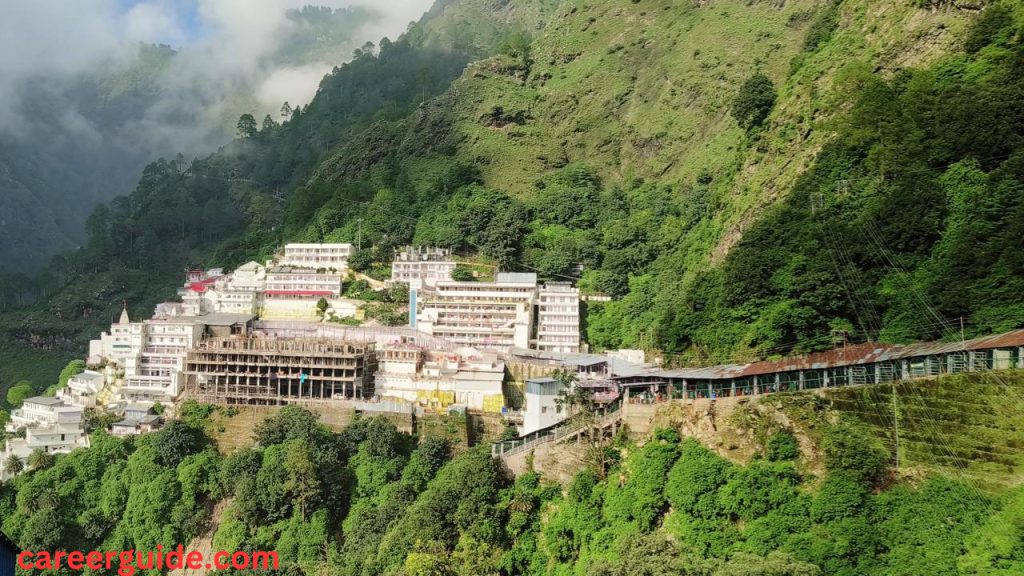The weather at Vaishno Devi, a respected pilgrimage web site nestled inside the Trikuta Hills of Jammu and Kashmir, India, is characterised with the aid of its distinct seasonal variations, each imparting a completely unique enjoy to its traffic. During the summer months, from May to July, the climate is surprisingly great with temperatures ranging from 5°C to 30°C, supplying a comfortable weather for the pilgrims venture the adventure. As the monsoon season units in from August to September, the area receives slight to heavy rainfall, making the trek route slippery but the surrounding scenery lush and verdant.
Autumn follows in October and November, bringing with it mild temperatures and a reduction in rainfall, making it an ideal time for visiting. However, the wintry weather months from December to February see the temperature dropping appreciably, regularly falling below freezing point. Snowfall is not unusual during this era, covering the route and the encircling hills in a white blanket, presenting breathtaking views however also posing demanding situations for pilgrims. Despite the bloodless, the iciness season attracts some of devotees, prepared with warm apparel and an indomitable spirit, keen to witness the serene beauty of the shrine amidst the snow.

Vaishno Devi Weather Today
| Day | High (°C) | Low (°C) | Conditions |
|---|---|---|---|
| Day 1 | 20 | 10 | Sunny |
| Day 2 | 18 | 9 | Partly Cloudy |
| Day 3 | 15 | 7 | Cloudy |
| Day 4 | 17 | 8 | Rain |
| Day 5 | 16 | 6 | Thunderstorms |
| Day 6 | 19 | 10 | Sunny |
| Day 7 | 20 | 11 | Partly Cloudy |
| Day 8 | 21 | 10 | Sunny |
| Day 9 | 15 | 5 | Rain |
| Day 10 | 14 | 4 | Snow |
A Season-by-Season Guide to Vaishno Devi Weather
A Season-by-Season Guide to Vaishno Devi Weather:
- Spring (March to May):
- Spring in Vaishno Devi brings mild temperatures and pleasant weather, making it an excellent time for pilgrimage and outdoor activities.
- Temperatures typically range from around 10°C to 25°C, with occasional showers, so it’s advisable to carry light rain gear.
- The surrounding landscape bursts into vibrant colors with blooming flowers, adding to the charm of the pilgrimage.
2. Summer (June to August):
- Summer months are relatively warmer in Vaishno Devi, with temperatures ranging from 15°C to 30°C.
- Despite the warmer weather, it remains a popular time for devotees to visit the shrine.
- Light summer clothing is recommended, along with adequate hydration, as temperatures can rise during the day.
3. Monsoon (September to November):
- Monsoon season in Vaishno Devi brings moderate to heavy rainfall, transforming the surroundings into lush greenery.
- While the rainfall rejuvenates the landscape, it can also lead to slippery paths and occasional disruptions in travel.
- Visitors should be prepared for sudden showers and carry appropriate rain gear and sturdy footwear.
4. Autumn (December to February):
- Autumn marks the onset of colder temperatures in Vaishno Devi, with temperatures ranging from 5°C to 15°C.
- The region experiences occasional snowfall, especially in the higher altitudes, creating a serene and picturesque ambiance.
- Winter clothing, including jackets, gloves, Vaishno Devi Weather Today and hats, is essential for comfortable exploration during this season.
Best Time to Visit Vaishno Devi
The first-rate time to visit Vaishno Devi may be summarized in the following 10 factors:
- Moderate Weather: The exceptional time to visit Vaishno Devi is throughout the months of March to May and September to November whilst the weather is mild and quality.
- Spring Bloom: March to May offers the beauty of spring with blooming plant life, enhancing the pilgrimage revel in.
- Comfortable Temperatures: During those months, temperatures variety from 10°C to twenty-five°C, imparting snug situations for outdoor sports and pilgrimage.
- Autumn Serenity: September to November brings the serene ambiance of autumn with colourful foliage, making it any other best time to go to.
- Avoiding Extreme Weather: It’s satisfactory to avoid extreme weather conditions including the new summer season months (June to August) and the peak Vaishno Devi Weather Today of monsoon season (June to August) whilst heavy rainfall can disrupt journey plans.
- Crowd Avoidance: Visiting during the shoulder seasons of spring and autumn enables avoid big crowds, allowing for a extra non violent pilgrimage revel in.
- Limited Rainfall: While there may be occasional rainfall during these periods, it’s far generally less than at some stage in the peak monsoon months, decreasing the hazard of travel disruptions.
- Snowfall: Winter months (December to February) bring occasional blizzard, adding a picturesque contact to the landscape, but travel may be greater tough because of bloodless temperatures and slippery paths.
- Festive Atmosphere: Consider traveling in the course of gala’s inclusive of Navratri and Diwali, which frequently fall at some stage in the favorable months of March to May and September to November, respectively, to revel in the festive ecosystem at Vaishno Devi.
- Personal Preferences: Ultimately, the satisfactory time to go to Vaishno Devi depends on non-public alternatives concerning Vaishno Devi Weather Today weather, crowd tolerance, and unique
Weather Forecasting Tools and Websites
Weather forecasting tools and web sites play a essential role in presenting up to date and correct climate facts to individuals, companies, and various industries. Here are a few popular climate forecasting equipment and web sites:
- The Weather Channel: The Weather Channel gives a complete internet site and cell app presenting climate forecasts, radar maps, and severe climate signals.
- AccuWeather: AccuWeather is thought for its special climate forecasts, inclusive of hourly, day by day, and prolonged forecasts, in addition to radar maps and weather news.
- Weather.Com: Weather.Com, additionally known as Weather Underground, offers neighborhood climate forecasts, radar maps, and climate news, in addition to person-submitted weather reports.
- National Weather Service (NWS): The NWS internet site offers reputable weather forecasts, warnings, and advisories for america, at the side of radar imagery and weather data.
- Weather Underground: Weather Underground provides hyper-nearby weather forecasts, crowd-sourced climate reports, and interactive radar maps through its website and cell app.
- BBC Weather: BBC Weather gives climate forecasts and information for places round the arena, along Vaishno Devi Weather Today with targeted forecasts for particular areas and towns.
- Google Weather: Google’s climate feature provides quick get entry to to cutting-edge weather conditions and forecasts immediately from the Google search engine.
- Windfinder: Windfinder makes a speciality of presenting forecasts for wind, waves, and weather conditions for places worldwide, making it famous amongst sailors, surfers, and outdoor fans.
- Dark Sky: Dark Sky offers hyper-nearby weather forecasts with minute-by-minute precipitation predictions, making it beneficial for making plans outside activities.
Interesting Facts About Vaishno Devi
Here are some interesting data approximately Vaishno Devi:
- Holy Cave: The Vaishno Devi shrine is placed interior a natural cave within the Trikuta Mountains of Jammu and Kashmir, at an altitude of approximately 5,two hundred feet above sea stage.
- Goddess Vaishno Devi: Vaishno Devi is thought to be a manifestation of the Hindu Goddess Mata Adi Shakti. She is worshipped as the Mother Goddess or Divine Mother, embodying the blended energies of the Hindu trinity—Brahma, Vishnu, and Shiva.
- Three Manifestations: The cave enshrines three natural rock formations representing the 3 Hindu goddesses—Mahakali, Mahalakshmi, and Mahasaraswati—which might be believed to represent the three one in every of a kind manifestations of Vaishno Devi.
- Pilgrimage: Vaishno Devi is one of the maximum visited pilgrimage web sites in India Vaishno Devi Weather Today , attracting hundreds of thousands of devotees each 365 days. Pilgrims undertake a strenuous trek of approximately 12 kilometers from the bottom camp at Katra to attain the shrine.
- Legend of Vaishno Devi: According to Hindu mythology, Vaishno Devi is believed to have taken safe haven in the cave to interrupt out the wrath of the demon Bhairavnath. She stayed in meditation for 9 months and emerged as a goddess to damage the demon.
- Ardaas: Devotees frequently carry out an ardaas, or prayer, earlier than embarking on the pilgrimage to are trying to find blessings from Vaishno Devi and specific their devotion.
- Bhairavnath Temple: At the cease end result of the pilgrimage, devotees visit the Bhairavnath Temple, committed to Bhairavnath, the demon who pursued Vaishno Devi. It is believed that the pilgrimage is incomplete with out journeying this temple.
- Navratri Festival: The pageant of Navratri, dedicated to the worship of Goddess Durga, is widely known with great fervor at Vaishno Devi. Devotees flock to the shrine for the Vaishno Devi Weather Today duration of this time
Weather-Related Attractions Near Vaishno Devi
Certainly! Here are 10 climate-associated points of interest near Vaishno Devi:
- Bhairavnath Temple: This temple, located near the Vaishno Devi shrine, gives lovely panoramic views of the encircling mountains and valleys.
- Sanjichhat: A famous stopover issue along the trek to Vaishno Devi, Sanjichhat gives breathtaking perspectives of the Trikuta Mountains and the encompassing panorama.
- Ardh Kuwari Cave: Situated midway along the trek, this natural cave is thought to be in which Mata Vaishno Devi concealed from the demon Bhairavnath. It offers a groovy retreat from the trek and a mystical environment.
Vaishno Devi Viewpoint: Several viewpoints close to the Bhawan provide site visitors with stunning vistas of the encircling mountains and valleys, particularly all through clear climate. - Ban Ganga: A sacred spring on the Vaishno Devi Weather Today start of the trekking path, where pilgrims often take a dip in its holy waters before starting up their adventure.
- Charan Paduka: This spot is concept to maintain the footprints of Mata Vaishno Devi and offers panoramic perspectives of the Himalayan tiers.
- Himkoti: Located en direction to Bhawan, Himkoti gives picturesque perspectives of the Himalayas and serves as a extraordinary spot to lighten up and enjoy the natural beauty.
- Banganga Temple: Situated close to the Banganga River, this temple gives a serene environment and awesome perspectives of the flowing river and surrounding landscapes.
- Katra: The base camp for the Vaishno Devi pilgrimage, Katra is surrounded by way of manner of lush greenery and offers a non violent retreat amidst nature.
- Trikuta Mountains: The majestic Trikuta Mountains, wherein the Vaishno Devi shrine is nestled, Vaishno Devi Weather Today provide awe-inspiring views and are a address for nature enthusiasts and photographers alike.
Conclusion
The climate at Vaishno Devi varies notably all through the year, providing numerous reports to pilgrims and traffic. Summers are slight and excellent, while the monsoon season brings slight to heavy rainfall, making the trek challenging but worthwhile with lush greenery. Autumn and spring offer best weather situations for travelling, with slight temperatures. Winters are bloodless, frequently followed via blizzard, growing a serene but chilly ecosystem. Despite the seasonal versions, pilgrims ought to stay informed about the climate forecast, get dressed accurately, and take essential precautions for a safe and pleasurable pilgrimage revel in at Vaishno Devi.
FAQs
During the summer months (May to July), the weather at Vaishno Devi is generally mild and pleasant, with temperatures ranging from 5°C to 30°C.
Yes, Vaishno Devi experiences moderate to heavy rainfall during the monsoon season, which lasts from August to September. Pilgrims should be prepared for slippery trekking paths during this time.
The best time to visit Vaishno Devi in terms of weather is typically during the spring (March to April) and autumn (October to November) when the weather is moderate and pleasant.
Yes, winters at Vaishno Devi, which last from December to February, are cold with temperatures often dropping below freezing point. Snowfall is common during this time, creating a picturesque but chilly atmosphere.




















